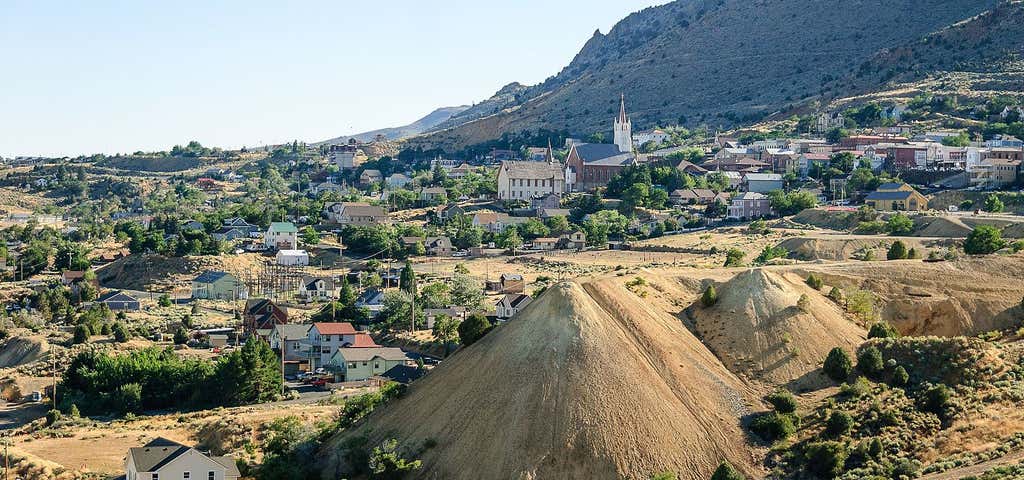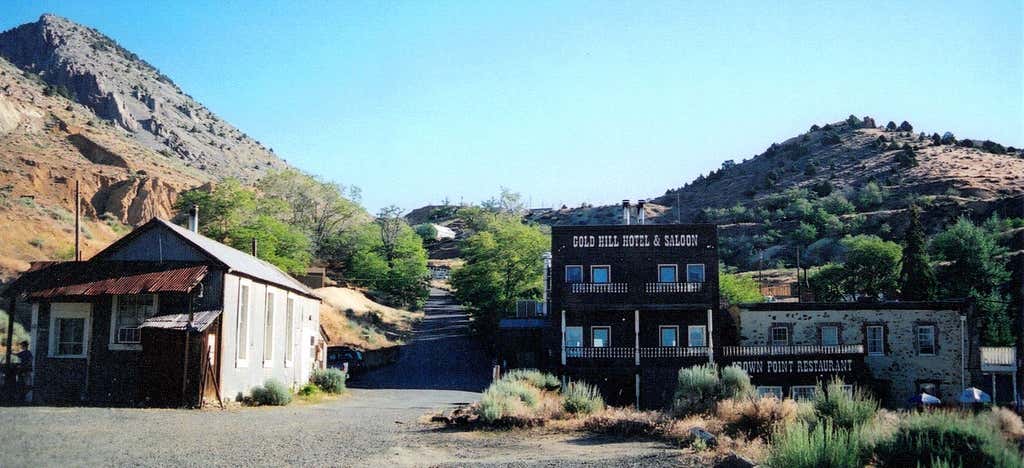A town as small as Virginia City, Nevada (population: 855) might seem pretty insignificant when compared to bustling cities, but this mining boomtown has actually influenced the course of American History, in more than one way. It all started with the discovery of the Comstock Lode, the first major silver ore discovery in the US, in 1859. This was about ten years after the California Gold Rush, and it attracted hordes of miners looking to strike it rich. The name, as the story goes, came from a miner (and Virginia native) named James Fennimore, who was more commonly known as "Old Virginny Finney". Some claim he "christened" the town by tripping at the door to the saloon and breaking a bottle of whiskey, while others hold that "Old Virginny Finney" was a legendary gold miner who could guess exactly where silver deposits were with eerie accuracy.
The town sprang up almost overnight, and became a massively wealthy boomtown, even by boomtown standards. Silver flowing out of Virginia City helped the Union win the Civil War and had a huge impact on the global economy. Nevada became a state in 1864, largely thanks to the huge population living in Virginia City at the time. At the town's peak in 1873, 25,000 people lived here and it was one of the richest cities in America. And, it's where Samuel Clemens first started finding success under the pen name he would use for the rest of his life: Mark Twain.
Today, even though Virginia City's population is a fraction of what it was at its peak, the town is still going strong. Many of the buildings were made of brick, so the Victorian downtown district has that awesome, Wild West vibe. There are tons of kitschy tourist attractions and historic landmarks to explore here. Explore Virginia City to step back in time and see how history was made!
The only hotel in the Virginia City area is the Gold Hill Hotel in the virtual ghost town of Gold Hill. It also happens to be Nevada's oldest functioning hotel. The original rooming house was known as “The Riesen House” and was built in 1861. Horace M. Vesey acquired the building shortly after, and added onto it as the town's population exploded. The Vesey House was the site of a lot of action back in the day; balls and cotillions, murders, the first attempt by miners to adopt a constitution, attempted murders, and a mini-disaster where a steam engine being towed through the streets of the town broke loose from its chains and smashed right into the Vesey House. But, the boomtown was dying by the 1880s, and in 1907, the building was being used as a private residence. But, it was turned back into a hotel, and renovations and additions have kept it a popular place to stay.
For comfort, there are modern hotel rooms with big beds, fireplaces, balconies, and more. For authenticity, request one of the original historic rooms. You'll find uneven floors and smaller spaces, but you can't beat the vibes in these rooms. For added atmosphere, Rosie's Room and William's Room are said to be haunted! Or, rent out one of the cabins if you've got a group. There's also an authentic saloon onsite (covered in dollar bills) and the sleek Crown Point Restaurant, where you can enjoy a meal of flame-broiled Angus steak or shrimp scampi.
2
Fourth Ward School Museum
One of the most stunning buildings in town is the Fourth Ward School. It was built in 1876 and held over 1000 students in grades 1-9 (with grades 10-12 being added in 1909.) It graduated its last class in 1936, and all the remaining students were moved to another school. The building itself was abandoned until 1986, when it was fixed up and reopened as the Fourth Ward School Museum.
Learn about the Comstock Lode, old-school mining, an 1870s classroom complete with potbelly stove, vintage printing equipment, exhibits on Mark Twain, and more. Especially interesting is the display of inventions inspired by the mining innovation going on in Virginia City and the wide variety of photographs of the town at its peak.
3
St. Mary in the Mountains Catholic Church
St. Mary in the Mountains was the first Catholic church in Nevada. The building now standing is not the first, or even the second church structure. It's the third, and was built in 1876. It's survived ever since, but even more brutal than the fire and winds was the identity crisis the church endured. A group of Cistercian monks tried to modernize the church in the 1950s, to the dismay of the residents. Today, it's been restored and is being well-preserved. It's a haven of peace and serenity in a town that went from being rough and tumble to nearly abandoned.
4
Ponderosa Saloon & Mine
Saloons are a dime a dozen in Virginia City; it's one similarity between the town's heyday and the present day. Ponderosa is worth a visit because right out back is a mine, and Ponderosa offers tours of it. It was built in the mid-1850s and was one of Virginia City's larger mines. The guided tours, led by friendly experts, are pretty wild. Afterwards, you can check out the building's 1864-era bank vault and grab a drink from the bar. If you're lucky, you might be around when live music or karaoke is on the schedule!
5
The Suicide Table at The Delta Saloon
The Delta Saloon was known for its gambling back in the day. The "Silver Kings", the richest men in Virginia City who owned large portions of some of the mines, reportedly like to play Faro in the back room, betting huge amounts of money like it was nothing. But, the saloon's claim to fame is the notorious "Suicide Table", the owner of which always seems to have gambling luck so horrible, it drives the man to end his own life.
It was originally a Faro Bank Table brought to Virginia City in the early 1860’s. The first death was Black Jake, who lost $70,000 in one night and shot himself shortly after. The table was stored for about 20 years after the second suicide until it was brought out in the late 1890s and used as a '21' table. This caused the third. The owner lost $86,000 in cash, a team of horses and an interest in a gold mine.... basically every earthly possession he owned. That caused the third suicide, and today the table is under glass, just in case anyone is tempted by it.
Today, the saloon serves as a kitschy bar and eatery, offering breakfast, lunch, and dinner. Enjoy the costumed servers and re-enactors and feel like you've stepped back into the Bonanza days.
6
Piper's Opera House
Piper's Opera House may not look like much, but it's seen quite a bit of Virginia City History. The current building was constructed in 1885, but the original dates to 1863. Mark Twain spoke at the first Piper's Opera House in 1866, a lynch mob hung a man from the theater's rafters in 1871, and in 1897, heavyweight boxing champion Gentleman Jim Corbett trained for a title bout against Bob Fitzsimmons here. It offers public tours between June and October, and plays host to all kinds of events throughout the year.
7
Mark Twain Museum Virginia City Nevada
Virginia City played a huge role in shaping the man that would become one of America's most iconic authors: Samuel Clemens, better known as Mark Twain. Samuel Clemens was born in Missouri and moved around from New York City to Philadelphia to St. Louis to Cincinnati before becoming a riverboat pilot. He wound up in Nevada with his brother who was the secretary to the governor of the territory. After exploring the West for a bit, he wound up in Virginia City. He attempted (and failed) to make it as a miner, which is probably a good thing for us; he went to work at a Virginia City newspaper for a friend instead. It was in Virginia City that he settled on the pen name Mark Twain. After about three years in Virginia City, he moved on to work as a journalist in San Francisco.
But there's no denying that Twain's time in Nevada had an impact on his work; he published several stories about his time in the West. The small Mark Twain Museum houses his old desk where he wrote, along with loads of vintage newspaper printer printing equipment. Add in the fact that the building the museum is in was one that survived the Great Fire of 1875 (thus preserving a lot of this incredible history) and you get an attraction worth checking out.
The Red Dog Saloon's first life was as the Comstock House, built in 1863. But, it didn't become legendary until over 100 years later, when proto-hippies took it over in 1965 and using it as a live music venue where psychedelic rock bands gathered to jam out to groovy San Francisco sounds in the Old West. Today, the Red Dog is a unique place to grab a drink and listen to some music unlike anything anywhere else in town. Beer, pub grub and cocktails on the menu enhance the experience.
9
Silver Terrace Cemeteries
One of the most striking places where you can experience Nevada history is at the Silver Terrace Cemeteries. When the need for burial grounds arose, various institutions and organizations started graveyards on the steep hills just outside Virginia City. As you can see from the dates on the graves, most are from before 1920, and the iron wrought fences and stones speak to Victorian funeral trends. Notice how very few adults were born in Nevada, and from how far away many came.
10
Way it was Museum
For a final glimpse into the history of Virginia City and an idea of what life was like back in the day, visit the Way it Was Museum. Photos, costumes, old newspapers, vintage tools and firearms, mining equipment, films, and more paint a vivid picture of what a day in the life of a miner during Virginia City's heyday was like.
Explore More Trip Guides
The Loneliest Road: A road trip along Nevada's Highway 50
- 24 Places
- 19:56
- 708 mi
The top things to do on an Extraterrestrial Highway road trip
- 7 Places
- 13:23
- 615 mi
The most epic American road trip
- 28 Places
- 191:21
- 11,212 mi












